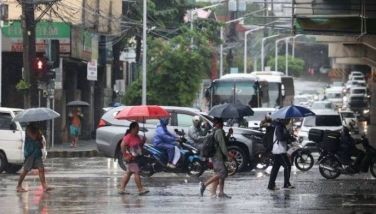NDRRMC orders preemptive evacuation in Luzon
Manila, Philippines - The National Disaster Risk Reduction and Management Council (NDRRMC) has ordered its field units to conduct preemptive evacuation in parts of Luzon and the Visayas that lie along the expected path of tropical storm “Helen.”
NDRRMC Operations Center head Edgar Ollet said preemptive evacuation may be necessary in Bicol, Cagayan and Cordillera regions, Leyte, Samar and parts of Aurora.
He said residents in these areas, which are facing the eastern seaboard, should be on alert for possible floods and landslides.
“One of the things that should be taken seriously is that the mountain slopes may be affected by the southwest monsoon. Residents in these areas should be careful,” Ollet said, noting that last week’s heavy rains had caused soil erosion.
The NDRRMC could not tell how many residents would be evacuated because of the storm.
Ollet, nevertheless, said their personnel are ready to provide assistance to residents who would be affected by the bad weather.
“We remain on red alert. Those in the evacuation centers were not allowed to return to their homes,” he said.
A red alert places all disaster management personnel on standby. It also entails the pre-positioning of supplies and equipment.
Ollet said they have been under red alert since the morning of Aug. 6, the date the southwest monsoon started to cause heavy rains and floods in Metro Manila, Ilocos, Central and Southern Luzon.
NDRRMC executive director Benito Ramos ordered his field units to monitor the situation in their respective areas and to undertake precautionary measures.
“Let us untiringly aim for zero casualties,” Ramos said in a memorandum issued to regional directors yesterday.
The death toll from the southwest monsoon rose to 92 while the number of affected residents climbed to 3.46 million or 761,189 families.
NDRRMC said 32 of the fatalities were from Metro Manila, six from Ilocos region, 38 from Central Luzon, 15 from Calabarzon, and one from Mimaropa.
More than one million persons or 216,328 families have been displaced. A total of 410,729 persons or 89,114 families are still in 930 evacuation centers, while the rest are staying with relatives and friends.
The floods have prompted local governments in Ilocos, Central Luzon, Calabarzon, Mimaropa, SOCCSKSARGEN and Metro Manila to declare a state of calamity. Such declaration allows local governments to use their respective calamity funds.
Areas that were placed under state of calamity are Manila, Marikina, Malabon, Navotas, Valenzuela, Muntinlupa, San Juan, Pasig, Pasay, Caloocan, Pateros, Pangasinan, Zambales, Pampanga, Bataan, Bulacan, Laguna, Rizal, Abra de Ilog in Occidental Mindoro, Culion, El Nido, and Linapacan in Palawan and Kidapawan City, Aleosan and Kabacan in North Cotabato.
The southwest monsoon also left 11 persons injured and four others missing.
The total cost of damage to infrastructure and agriculture has reached P616.38 million.
“We have not yet fully recovered and here comes another storm. We will continue with our alert levels until we see the full effects of this approaching weather disturbance,” Ramos said.
Too costly
The number of affected families due to floods in Central Luzon has already reached 475,928 or 2,082,442 individuals.
The Regional Disaster Risk Reduction and Management Council (RDRRMC) said that the affected families numbered 95,401 in Bataan, 90,348 in Bulacan, 16,107 in Nueva Ecija, 221,552 in Pampanga, 21,434 in Tarlac and 31,086 in Zambales.
At least 1,301 villages in the six provinces in Central Luzon were affected by floodwaters since the start of heavy rains.
The RDRRMC also reported that total damage in infrastructure and agriculture has reached P1.577 billion.
Damage to infrastructure were in Bataan (P10.7 million) and Zambales (P42.31 million), while agriculture losses were in Bulacan (P364.96 million), Pampanga (P1.15 billion) and in Zambales (P56.8 million).
Pampanga Gov. Lilia Pineda said the province is still in critical condition, as a majority of the municipalities remain inundated.
Pineda urged residents living adjacent to Pampanga River to secure their families by moving temporarily to safer ground.
Safe water a concern
Meanwhile, the Department of Health (DOH) has directed the Metro Manila Drinking Water Quality Monitoring Committee (MMDWQMC) to test the water being supplied by two concessionaires to the metropolis in the wake of massive flooding that hit the region in the past weeks.
DOH director for National Capital Region (NCR) and MMDWQMC chair Eduardo Janairo ordered the testing to ensure that the water being supplied by Manila Water Co. Inc. and Maynilad Water Services “is safe to drink.”
Janairo said the water samples will have to undergo physical, bacteriological and chemical examinations to check if they are still potable.
The MMDWQMC is a multi-agency committee that regularly collects water samples and tests them to ensure water quality.
In an earlier interview, engineer Nilo Marayag, head of DOH-NCR’s Environmental Health and Sanitation Cluster, said the risk of water contamination is higher during rainy season when water pipelines get submerged in floods.
Marayag warned that pollutants easily seep into pipelines that have leaks.
The DOH-NCR has deployed a mobile water treatment unit that will provide purified drinking water to people in evacuation centers.
Janairo said the water treatment facility is “very suitable because it can supply clean and potable drinking water in an instant, especially in times of emergency, water shortages and calamities.”
A mobile water treatment system is involved in applications such as drinking water preparation and water production process for water shortages.
It offers a range of treatment processes such as oil/ water separation, sedimentation, filtration and disinfection.
The unit is placed closely to the source of raw water to be processed and it can process up to 12,000 liters of purified water per hour. The water product in this mobile treatment unit is safe for consumption. – With Sheila Crisostomo, Ric Sapnu
- Latest
- Trending






























